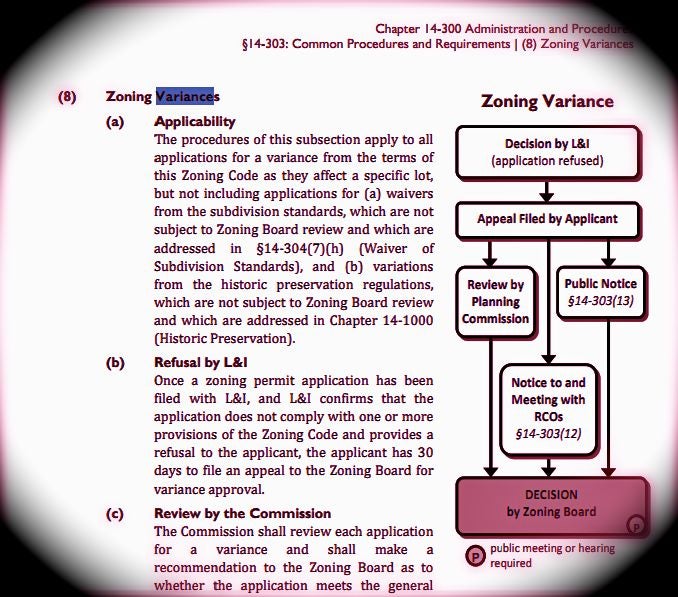Close-reading the Final Report: zoning variances

The Zoning Code Commission officially adopted its Final Report a few weeks back, and Councilman Frank DiCicco recently introduced a bill to City Council which would replace the city’s current code with that report. Pending any further amendments by Council, Philadelphia appears to be on the brink of adopting a new zoning code. If Council passes DiCicco’s bill by the end of the year, the ZCC’s Final Report will become law in August 2012, after an 8-month interim period.
The merits of the Final Report as compared to the current code can be debated, but one stark improvement is the way the report clarifies and organizes information. Eighteen sections have been reduced to ten, 642 pages condensed to 402, and a monstrous section entitled “Miscellaneous” that contains provisions affecting the function of the entire code has been removed. We’re not suggesting that to read the Final Report is to take a walk in a Parks and Open Spaces District on a fine spring day—it’s still legislation—but comparatively, it just makes more sense.
The report accomplishes this improved sense-making not only through condensing and reorganizing, but also by visualizing information wherever possible. Many of the legal development processes described in §14-300 (“Administration and Procedures”) are accompanied by simple graphs. For example, the provision on zoning variances, §14-303(8), includes all the necessary legal detail along with a chart showing exactly how the procedure works. The Final Report further clarifies zoning variances by defining them, something the current Code doesn’t explicitly do.
A variance—“A relief from the provisions of this Zoning Code that allows use or development of a lot outside the zoning provisions applicable to that lot”—works like this:
- A builder files an application to use or expand a building in a way that is not permitted in the zoning code.
- The Department of Licenses and Inspections denies that application.
- The applicant appeals L&I’s decision to the Zoning Board of Adjustment.
- The Philadelphia City Planning Commission reviews the application, and makes a recommendation to the ZBA about whether it meets the general criteria for granting a variance.
- The applicant provides notice to any Registered Community Organizations in the vicinity of the proposed variance, and holds a meeting with them.
- The ZBA provides public notice of a hearing to be held on the variance.
- The ZBA grants the variance, denies it, or approves it with conditions.
Just as in the case of zoning bills before City Council, the Planning Commission’s role is advisory, and its recommendations have no legal power in granting or denying a variance. The only agencies given authority by the zoning code are the ZBA and L&I.
The provisions describing the process of applying for a variance are followed by a long list of criteria that must be met in order for the ZBA to approve the variance. These criteria essentially mirror those listed in the current Code, though some have been combined into the same subsections. Generally, they serve to keep variances as insignificant as possible and to prevent them from adversely affecting surrounding properties and public space. The ZBA has the authority to grant “a lesser variance than requested.”
In addition to the current Code, the Final Report can also be compared to the Preliminary Report, the earlier draft of the new zoning code, issued by the ZCC in May. That report contained one criteria for variance approval that has been removed from the new version: “That the use variance, if authorized, will represent the minimum variance that will afford relief and will represent the least modification possible of the regulation in issue.”
The Final Report also contains a single-sentence addition which wasn’t included in the first report: “If the Zoning Board chooses to view the subject property as part of the hearing, the Zoning Board must provide due process.” In fact, the entire provision on zoning variances that appeared in the Preliminary Report was stricken and replaced with new language in the Final Report. Substantively, however, the differences are few.
In theory, clarifying the language of the zoning code will do more than simply make it easier to comprehend. One of the goals of the zoning reform project was to craft a code that would minimize the number of variances and appeals to be considered by the ZBA. Deputy Mayor Alan Greenberger has been fond of pointing out that Philadelphia has more cases before its zoning board annually than New York, a city with more than four times our population. Clarifying the zoning code and, in turn, the development process, should reduce the amount of relief from zoning laws property owners will need to seek.
From the time the Zoning Code Commission was created, all its efforts were aimed at making the zoning rules for the City of Philadelphia as understandable, predictable, and city-wide as possible. In language and relative length, the Final Report succeeds in doing that. But toward the end of the reform process, some of the Commission’s foundational goals were set aside under growing—and not necessarily unjustified—pressure from some neighborhood groups, City Council members, and other stakeholders. One major example: many ZCC members originally wanted to wipe the code clean of overlays, sections that provide different rules for different parts of the City. Overlays, some felt, compromise the predictability of the development process. But by the time the Final Report was adopted, overlay controls for a number of districts—Germantown and Northern Liberties are two big ones—had been added back in.
So the Final Report is easier to read, and will likely be easier for developers to navigate. But whether it will have the desired effect of reducing ZBA hearings in a city where builders have become accustomed to using variances to get around the rules—we’ll have to wait at least eight months to see.
Contact the reporter at jaredbrey@gmail.com
WHYY is your source for fact-based, in-depth journalism and information. As a nonprofit organization, we rely on financial support from readers like you. Please give today.



